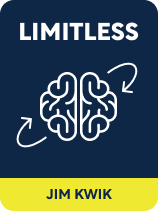

This article is an excerpt from the Shortform book guide to "Limitless" by Jim Kwik. Shortform has the world's best summaries and analyses of books you should be reading.
Like this article? Sign up for a free trial here .
What is exponential thinking? How is it different from incremental thinking?
Too often people think in incremental terms—one step at a time. With exponential thinking, however, each step is bigger than the previous step. It’s an exponential mindset that leads to exponential success.
Read on to learn about exponential thinking.
Limitless Action Starts With Exponential Thinking
In Limitless, Jim Kwik discusses not only how to learn but also how to think. Once you’re capable of learning anything, the next step is using all of your new knowledge to its maximum potential. In other words, Kwik teaches you how to move from limitless learning to limitless action.
Think Exponentially
Kwik urges us to stop thinking incrementally (one small step at a time) and start thinking exponentially (each step bigger than the one before it). According to Kwik, exponential thinking leads to world-changing innovations and billion-dollar companies.
| Entrepreneur Mark Bonchek first wrote about developing an exponential mindset to complement the exponential growth of technology. The crux of his argument was that many businesses fail because they have incremental mindsets in an exponentially advancing world. Bonchek encourages business leaders to make strategies that grow slowly at first, but lead to ever-accelerating rates of return. However, Bonchek’s method claims that you can’t predict the future while using an exponential mindset—he likens an exponential growth curve to a bend in the road that you can’t see beyond. In contrast, Kwik’s model is all about predicting and planning for the future, as we’ll see shortly. |
Exponential thinking encourages us to look beyond the immediate problem and instead seek the root cause of that problem. Solving the underlying issue will most likely have a much greater impact than just fixing the current problem.
1. Find the underlying problem. The problem you’re trying to tackle might not be the real issue at all, so look for a root cause. For example, if you’re trying to reduce air pollution, you might tackle that problem at the source by addressing “dirty” energy sources like coal and oil.
| Kwik urges us to look for root causes, but doesn’t provide much guidance on how to do that. The Design of Everyday Things suggests finding the root cause of a problem by continuously asking “why.” For example, if the problem you’re trying to solve is that you always buy unhealthy fast food on the way home from work, your “root cause analysis” might go something like this: Why am I buying fast food? Because I’m hungry. Why am I hungry? Because I haven’t eaten in a while. Why haven’t I eaten? Because I was at work. Why did being at work stop me from eating? Because I didn’t have food there. Why didn’t I have food at work? Because I didn’t bring any. You could continue with this line of questioning (“why didn’t I bring food to work?”), but the solution to your underlying problem should be clear by now: Bring your own food to work, and you won’t be tempted to buy junk food on the way home. |
2. Ask “what if.” This isn’t just about asking what might happen if you do one thing or another; try to come up with extreme, and even outlandish questions. These seemingly strange questions will get you thinking along different paths than everyday linear thinking would. For example, instead of looking for cleaner energy sources, what if we could make a society that didn’t need electricity at all?
(Shortform note: An article from Forbes offers one reason why “what if” questions can be effective brainstorming tools: they encourage you to approach the situation with an open mind. When you ask yourself “what if,” you let go of your ideas about what’s possible or feasible, and simply try to answer the question.)
3. Study. Now that you’ve found the root problem and thought about some hypotheticals on your own, it’s time to see what other people have to say about that situation. Try to get a well-rounded view of the issue by studying many different (reliable) sources.
(Shortform note: One of the internet’s major pitfalls is that you can find sources supporting any idea or theory you can imagine, no matter how outlandish. Therefore, it’s important to vet your findings, and to take information only from reliable sources. This article from the University of Georgia offers some pointers; most importantly, checking a site’s credibility and the author’s credentials before taking anything on that site as fact.)

———End of Preview———
Like what you just read? Read the rest of the world's best book summary and analysis of Jim Kwik's "Limitless" at Shortform .
Here's what you'll find in our full Limitless summary :
- Jim Kwik's guide to meta-learning: learning how to learn
- How to quickly and effectively learn about any topic
- How to use your new knowledge to its maximum potential






